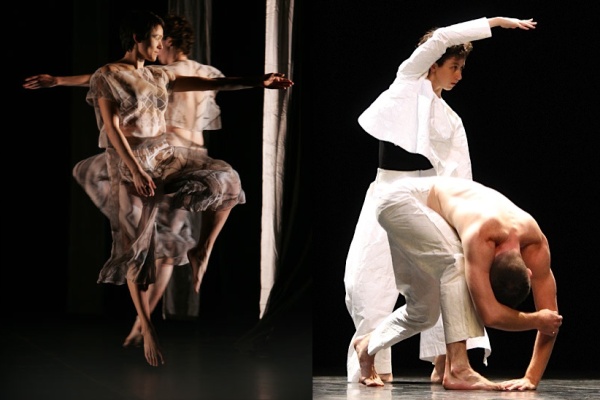Essay by Mary Mann

Two men in gray unitards squat forwards in unison and place their hands on their thighs, backs to the audience, faces towards a stage-sized canvas painted red. A girl dances in, also in a unitard—in fact, it’s not clear if she’s dancing or walking, one could say she’s walking in a fancy way, or dancing in a casual way. Either way, she bends forward in a movement reminiscent of yoga and then bends back again. The men begin to move. Another girl dance-walks out and then another and soon they are all dance-walking into yoga and back into dance-walking again. They seem to be made of nothing but muscles and springs.
There is a sound like an infinite foghorn. In the audience sit several hundred New Yorkers who would surely register strong complaints with the landlord if such a sound occurred in their own building. But this is a Trisha Brown Company performance, and the audience has lowered their aggression levels. Another canvas the size of the stage lowers down and obscures all but two of the dancers, who appear not to notice and keep doing their thing—a man and a woman, leaning towards and away from each other, both wearing identical grey unitards like some sort of mandatory earth-man uniform in an old sci-fi movie.
The foghorn noise stops.
The theater is so quiet that the soft grunts and heavy breathing of the dancers echo.
She balances on him, he balances on her. Give, Take. Give, Take.
The foghorn blares again suddenly and we’re jolted from the intimacy of the scene. Another painting
The dance-walking reminds me of ribbon dancing at the Olympics, which is an event that many people in my life (actually, mostly just the men) make fun of but which I enjoy. As a little girl in the 1990s I coveted a Kidpower Ribbon Dancer—the 1-800 commercial told me all I needed to know, “Ribbon dancer, having so much fun/Ribbon dancer, gotta get one!”—but when I got one for Christmas I only succeeded in tangling it around my ankles. I admire the dexterity of the Olympic ribbon dancers, and also their poise, which allows them to do something ridiculous without prompting the viewer to laugh.
While my mind wandered to ribbon dancers I missed something. Now they’re bowing—it’s intermission. I feel guilty but only for a minute. My lapse has given me an insight as to why I enjoy modern dance, at least of the choreographed Trisha Browne variety: these dancers are doing ridiculous things, things I would love to do in the middle of the crowded New York sidewalk to liven up a drab day, but never would because I would be afraid of being laughed at. But they’re not being laughed at. They’re living out a fantasy without having to pay the consequences. They’re the surrogate ridiculous.
I never would have thought of that if I hadn’t zoned out, and I never would have zoned out if modern dance were more interesting. Say, if it had a plot. Or some flashy CGI images.
Brown has been in the business of challenging our ever-decreasing attention spans since 1970, when she formed the Trisha Brown Dance Company. A persistent presence in modern dance for over four decades, she’s never seemed to be afraid of appearing ridiculous, or of boring her audience: she might roll around on the floor, spread her butt cheeks, paint her hands blue, or just stand there. It’s all part of her creative process, which is so contagious that everyone in modern art seems to want to work with her: from performance artist Laurie Anderson to visual artist Robert Rauschenberg to choreographer Merce Cunningham.
Everybody has a different take on modern art; it’s been called both insightful and insipid, inspired the awe of New Yorker writers and the mockery of The Simpsons. I find a lot of modern art, and modern dance in particular, pretty boring—but I like that.
After all, there’s a boon to boredom. John Cage, (also a collaborator of Trisha Brown) once said: “If something is boring after two minutes, try it for four. If still boring, then eight. Then sixteen. Then thirty-two. Eventually one discovers that it is not boring at all.”
A lot of modern dance is intentionally boring. It is willfully boring because we modern people need it to be. We have no time for boredom otherwise. The Internet killed boredom, and its sidekick the smartphone delivered the final, killing blow. Et tu, Twitter?
“You can’t win, Darth. If you strike me down, I shall become more powerful than you can possibly imagine.” That’s Obi-Wan Kenobi in Star Wars: A New Hope, but it could just as easily be boredom. Because if John Cage is right—that if we submit to boredom for a significant length of time, then our senses will adjust to find excitement within the boredom—then the reverse is also true: if we avoid boredom by texting and emailing all day then by nightfall we might very well find ourselves truly and awfully and soul-crushingly bored. The problem is that this particular brand of boredom is all product and no process. We didn’t sign on to endure that boredom, and so we can’t possibly appreciate it.
Over the intermission I hear a woman in front of me say to her companion that Brown, at seventy-six years old, is stepping down as artistic director of the Trisha Brown Dance Company. Two out of the five dances performed tonight are new, and they will be her last. “She hasn’t been well as all,” clucks the lady in front of me, and her companion shakes her head sadly, as if Brown is a personal friend of theirs.

Big industrial fans are blowing on stage now. It looks like the dancers are wearing karate outfits. Same dance-walking is going on. No paintings this time. There’s a guy on a piano playing something that sounds just bananas. In the crowd a few faces are spookily lit by the glow of iPhones, which doesn’t seem to bode well for the future of beneficent boredom. I worry easily. But when I take in the whole audience—craning my neck to see everyone in the packed house—most are watching intently, eyes either rapt or glazed over in thought. It’s easy to imagine Brown, watching somewhere in the wings, also lost in thought; zoning out, perhaps, on one of her own famous quotes: “Value the process.”
This piece is based on a January 31, 2013 show at the Brooklyn Academy of Music (BAM). The dances performed were: Les Yeux et l’âme (New York premier), Set and Reset (1983), Homemade (1966), Newark (1987) and I’m going to toss my arms—if you catch them they’re yours (New York premier)
—
Originally from Indiana, Mary Mann currently lives in New York City, where she is an MFA candidate at Columbia University. She is an essays columnist for Bookslut, and her work has also appeared in The Rumpus and New York Magazine, among others.




